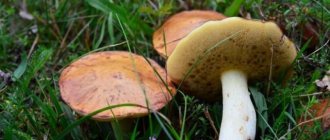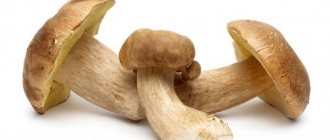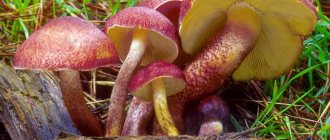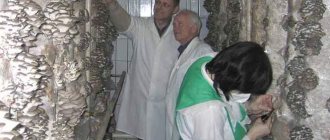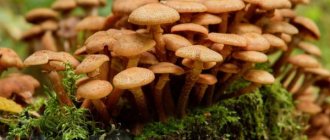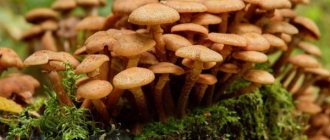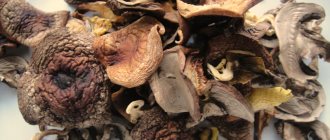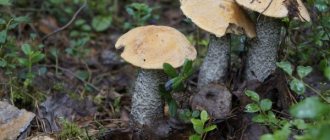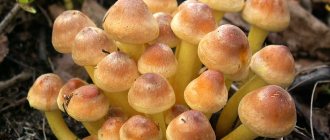There are a number of nuances that you need to know before going for mushrooms. Focusing on rain, we must not forget that each type of mushroom has its own ripening rate. The species also differ in how many days the mushrooms appear after rain. For some, this happens very quickly - within a few hours. Others take several days, or even weeks, to reach maturity.
Long-term observations have shown that there are certain patterns in the growth of fungi after precipitation. Generally speaking, they can actually be seen just a few hours after precipitation falls. But it’s too early to go “quiet hunting” - it’s better to do it in 2-3 days. Sometimes it takes longer.
For your information! Butterflies reach full maturity in a couple of days, but boletuses will need 4-5 days for this. Porcini mushrooms will be ready to move into the mushroom picker’s basket in almost a week.
During the ripening process, mushrooms gain not only in height, but also in weight. This is precisely what the weather conditions that set in after quiet mushroom rains favor: moderate humidity and warmth.
Rain and other factors affecting mushroom growth
The fact that mushrooms grow rapidly after rain is not a completely true statement. Rain alone cannot cause massive mushroom growth. A lot of other factors also influence the growth rate. The most significant of them are the following:
- Temperature.
- Humidity.
- Lighting.
- Chemical composition of the soil.
- Harmful insects.
This is interesting!
The optimal temperature regime for active growth is considered to be a range from 18 to 30 degrees. If the air temperature goes beyond these limits, growth slows down or stops altogether. Temperature fluctuations also negatively affect the development of fungi. The humidity factor involves two components: air humidity and soil moisture. Each species has its own preferences in this regard, but, if we take the statistical average, the optimal humidity level for good growth is considered to be 70%. Soil moisture should correspond to air humidity. If a prolonged drought occurs after heavy rains, the mushrooms will grow slowly because the moisture in the soil will evaporate quickly. Thus, the soil will become dry and the air will become waterlogged, which will upset the balance.
Mushroom growth
Proper lighting plays an important role in active mushroom growth. Many species prefer to grow in sunny meadows or partial shade. If the forest grows too much, they don't have enough light. As a result, they slow down their growth and become deformed, losing their visual appeal.
Most edible mushrooms prefer slightly acidic soil. The only exceptions are a few species that grow well in sandy, limestone or other types of soil. Interventions in the chemical composition of the soil lead not only to growth stagnation, but also to the extinction of entire fungal families.
Indicators of optimal temperature and humidity for mushroom growth
Mycelium with its terrestrial parts are at risk of infection by the larvae of some types of harmful insects. Affected myceliums bear fruit poorly, and the mushrooms are small and grow very slowly. Mechanical damage provokes rot and other serious diseases. Active growth of most mushroom species occurs in the fall. Then the process of mass decay begins.
In the understanding of most, mushrooms are fruiting bodies, most often consisting of a stem and a cap. In fact, it is only the terrestrial part of a complex organism. The mycelium, or mushroom place, is located under a layer of soil, growing systematically throughout its life. The growth of mycelium is not affected by weather conditions; it grows equally both after heavy rain and during severe frosts.
Find out when and where it is best to pick mushrooms in the Moscow region.
When to collect boletus mushrooms in the fall
Boletus mushrooms, especially young and strong ones, are in no way inferior to white ones - even boiled, dried, or fried. And if they go in layers, then you can collect more than one bucket of them in a relatively small forest.
According to popular belief, the first boletuses appear when the mountain ash blooms, and then they do not leave forest glades and birch groves all summer. Unless, of course, the summer was too hot and dry. But the summer boletus has one drawback - the worm really loves this tasty mushroom. So the mushroom picker has to reluctantly throw away one mushroom after another.
In autumn, boletus flowers are clean and strong. And besides, their special appearance appears - with a thick stem and a dark cap, the taste is practically no different from the white one. Finding it, however, is not easy in the fallen leaves. But if you come across one, then you can find a dozen more around it.
At what temperature do mushrooms grow in autumn (boletus mushrooms)? they have almost the same as the whites. For boletus, 10-12 degrees Celsius is quite enough, only these mushrooms love wetter weather, not prolonged rains, but thick autumn fogs. And if the autumn is dry, then boletus mushrooms should be looked for in damp places, in lowlands and even in a swamp.
A good mushroom picker knows at what temperature mushrooms grow. In the autumn, in the forest, he will quickly fill a basket, or even take out a bag - don’t leave boletus and boletus, aspen and boletus, milk mushrooms and milk mushrooms under the fir trees and birches! And if honey mushrooms attack, there may not be enough packages.
Autumn time is famous not only for the beauty of nature preparing for hibernation, but also for its gifts. And we will not talk about what we grew in our garden, but about what our forests are rich in. Namely, about mushrooms. Moreover, these amazing creatures of nature are associated with a lot of folk signs and superstitions that mushroom pickers have noticed.
The best time to collect different types of mushrooms is in summer and autumn
The first mushrooms appear in April, but May is considered the official opening month of the mushroom season. Usually mushroom hunting lasts until October inclusive. But if weather conditions are favorable, new mushrooms grow in November and even in December.
It is better to harvest according to the mushroom calendar. Based on his data, the mushroom picker is less likely to run into an inedible double. The following table details the entire growth period of certain edible species.
| Species name | May | June | July | August | September | October |
| Porcini | + | + | + | + | + | |
| Valuy | + | + | + | + | + | |
| Volnushka | + | + | + | + | + | |
| Volnushka white (Belyanka) | + | + | ||||
| Gorkushka | + | + | + | + | ||
| Gruzd | + | + | + | + | ||
| Raincoat | + | + | + | + | + | |
| Greenfinch | + | + | + | |||
| Kozlyak | + | + | + | + | ||
| Cap | + | + | + | + | ||
| Chanterelle | + | + | + | + | + | |
| Oiler | + | + | + | + | + | |
| Mosswort | + | + | + | + | ||
| Honey fungus | + | + | + | |||
| boletus | + | + | + | + | + | + |
| Boletus | + | + | + | + | ||
| Ryzhik | + | + | + | + | ||
| Ryadovka | + | + | + | |||
| Serushka | + | + | + | + | ||
| Violin | + | + | + | |||
| Morel | + | |||||
| Russula | + | + | + | + | + | + |
| Champignon | + | + | + | + |
The first harvest is much smaller than the harvest collected during the period of active mushroom growth. The following provides data on the peak growth activity of certain edible species.
| Species name | May | June | July | August | September | October |
| Porcini | + | + | ||||
| Valuy | + | + | ||||
| Volnushka | + | |||||
| Volnushka white (Belyanka) | + | |||||
| Gorkushka | + | + | + | |||
| Gruzd | + | + | ||||
| Raincoat | + | + | ||||
| Greenfinch | + | + | ||||
| Kozlyak | + | + | + | |||
| Cap | + | + | ||||
| Chanterelle | + | + | ||||
| Oiler | + | + | ||||
| Mosswort | + | |||||
| Honey fungus | + | + | ||||
| boletus | + | + | ||||
| Boletus | + | + | + | |||
| Ryzhik | + | + | ||||
| Ryadovka | + | |||||
| Serushka | + | + | ||||
| Violin | + | + | ||||
| Morel | + | |||||
| Russula | + | + | + | + | ||
| Champignon | + | + | + | + |
An interesting fact is that during Indian summer you can find varieties from all seasons of the year. And after it, mushroom pickers can only collect the remains of the autumn harvest and winter honey mushrooms.
Duration of the mushroom period for different species
In warm, sunny weather, many new mushrooms appear in the forest after a good rain. In order to determine the mushroom age, it is enough to simply know the duration of the growth period of certain species.
The most common types of Russia have the following growth periods:
- porcini mushrooms reach large sizes already 2-3 days after warm rain;
- boletus: young fruits are harvested 5-7 hours after the rain, fully ripen on the 3rd day, after which they are already considered spoiled;
- boletuses grow several cm per day;
- boletus takes about 4-5 days to fully ripen;
- Honey mushrooms appear 24 hours after rain and take a week to reach maturity;
- young chanterelles wait up to 3 weeks;
- Vessels and morels can gain up to 30 cm in 1 hour.
Most species grow in 3 to 5 days. Full ripening usually occurs on the 10th day. It is noteworthy that fungal organisms grow equally actively both during the day and at night, without wasting time on rest. As autumn approaches, growth slows down. This is due to a decrease in air temperature.
How long do Morels grow? Spring delicacy Morels at the dacha (5 photos)
In the April forest, among still bare bushes on dark brown soil not covered with grass, the first spring flowers seem especially bright: blue liverworts, pink-blue lungworts, white snowdrops. Simultaneously with the first flowers, the first mushrooms appear - morels. The ancient Romans considered them a delicacy and served them at the table of the emperor. You can also grow these delicious mushrooms in your garden.
Mysterious, unusually shaped, without the usual tubes or plates, cool to the touch morels and lines appear before other mushrooms. They often grow on unturfed soil along forest edges, in clearings, near forest roads, and in small forests. Under certain conditions, the stitches can become poisonous and it is best not to eat them. But morels, which are similar to them, are both nutritious and healthy. These mushrooms can be distinguished from each other by their cap. In morels it has a fairly regular cellular surface, while in stitches the top is folded or wavy. Morels have been known to people for a very long time. We find the first mention of them in the ancient Greek scientist Theophrastus, who lived in the 4th century BC. e. The aristocrats of Ancient Rome, who considered morels a delicacy, did not trust their servants to prepare them, but did it themselves and served it to the table on expensive dishes. In many countries, these mushrooms are still treated with respect. For example, in the USA, boiled morels are served annually at a banquet on the occasion of the congress of American mycologists - mushroom specialists.
Despite all their taste benefits, according to the classification, morels are considered conditionally edible mushrooms, so before preparing culinary delights from them, you must cook for 15-20 minutes, drain the liquid, and rinse the mushrooms with cold water. What are they? Three types of morels grow in the middle zone. First of all, this is the most common and easily recognizable conical morel. It has a conical, elongated, pointed dark brown cap with ribs and regular, almost rectangular cells on its surface. The cap sizes are from 2 to 8 cm long and 1.5-4 cm wide. The leg is cylindrical, often with grooves, white or yellowish, 2-4 cm long and 1.5 cm thick. In addition to coniferous and mixed forests, this mushroom can be found in wastelands, along the edges of fields, in gardens and groves.
The common morel differs from the conical one in the ovoid shape of the cap and irregular, rather rounded, cells on its surface. It grows mainly in deciduous forests and parks. Reaches a length of 6-15 cm. The morel cap has a bell-shaped, brown or dark yellow cap, 2-4 cm long and 2-5 cm wide, with narrow, longitudinal, wavy folds on its surface. It is loosely put on a cylindrical whitish stem, so that its edge does not grow to the stem, like other morel mushrooms. The length of the stem is from 6 to 14 cm, and the thickness is about 2 cm. The morel cap grows in clearings in light deciduous forests, especially often under linden and aspen. Morels have been grown in gardens for over 100 years. Two methods of cultivation have reached our time, and we will introduce you to them.
German way. In the spring, pieces of morels collected in the forest are washed, and then scattered among the grass under the apple trees and watered with water remaining from washing - such water contains fungal spores. Planting sites are covered with ash, and in the fall they are covered with fallen leaves of an apple tree or small-leaved trees (for example, birch), or a layer of straw. Next spring, the cover of leaves or straw is carefully removed, leaving only a thin layer to protect the mycelium from drying out. Two weeks after this, the first morels usually appear. Such a plantation will delight you with mushrooms for several years
French way. It is based on the observation that in orchards, morels grow best where rotting apples remain unharvested. With this method, morels are grown in ordinary beds. In spring, pieces of mushrooms are also scattered on them. In autumn, the bed is loosened and covered with a layer of apple pomace or other waste left over from the preparation of juices and jams. For the winter they cover with leaves, and in the spring the cover is removed. All you have to do is choose a more suitable method and start growing morels in your garden in order to get fresh mushrooms in the spring for preparing delicious gourmet dishes without spending much money and effort.
Rules and gathering places after rain
Experienced mushroom pickers always follow the basic rules of mushroom picking:
- Do not add suspicious fruits to your basket.
- Collect only well-known species, otherwise there is a risk of confusing edible mushrooms with their poisonous counterparts.
- Cut off the mushroom units with a knife, and do not break them with your hands, so as not to damage the mycelium.
- Do not harvest near roadways or industrial centers.
- Observe the subtleties of the technology for collecting and preparing certain types.
Each species has its own habitat preferences. The following table summarizes the distribution locations of the most famous types of mushrooms.
| Species name | Places of distribution |
| White | Old deciduous and coniferous forests, mainly under oaks |
| Valuy | Deciduous plantings |
| Volnushka | Coniferous plantations, deciduous forests |
| Belyanka | Coniferous plantations, deciduous forests |
| Gorkushka | Sunny forest glades |
| Gruzd | Mixed forests |
| Raincoat | Floodplain forests, glades, park areas |
| Greenfinch | Mixed type of forest plantations |
| Kozlyak | Mixed plantings |
| Cap | Sunny forest glades |
| Chanterelle | Deciduous and coniferous forest plantations |
| Oiler | Coniferous forest plantations |
| Mosswort | Deciduous and coniferous forests |
| Honey fungus | Dead deciduous trees |
| boletus | Deciduous forests, mainly under birch trees |
| Boletus | Deciduous plantations, mainly under aspen trees |
| Ryzhik | Mixed type of forest plantations |
| Ryadovka | Forest edges, bushes, parks and squares |
| Serushka | Floodplain forests |
| Violin | Mixed plantings |
| Morel | Floodplain forests |
| Russula | Coniferous and deciduous forests |
| Champignon | Shrubs, roadside plantings |
You can harvest mushrooms from May until the first frost.
How does porcini mushroom grow?
This is, of course, the most valuable trophy! Every mushroom picker's dream. But, as many people know, its color is not white at all. They called it that because it is the only one that does not darken when dried. In nature, it can be either brown or brown, or light, depending on the forest in which it grows. The porcini mushroom immediately catches your eye - large, stately.
It often grows along paths, in clearings and forest edges. He “loves” pine forests and oak forests. It also grows in birch groves and spruce forests. This species is very demanding on conditions, and therefore there is never a lot of it in the forest. How fast do porcini mushrooms grow? This has already been mentioned above. Usually this is one week, maximum 10 days. An old mushroom has yellow or green flesh under its cap.
Briefly, we can say the following about them. Porcini mushrooms grow in different forests, both coniferous and deciduous, but the most prolific in this regard are dry, well-warmed birch forests, preferably with sandy soil.
They begin to bear fruit at the very end of June, but the most massive appearance of fruiting bodies is observed in July - closer to August. September is the latest time when you can pick porcini mushrooms; in October they disappear.
They grow all summer, but in “waves.” Kolosoviki are the first species to appear. In order to be absolutely sure that whites can be found, you can go on a quiet hunt at the end of June. The second wave begins approximately from mid-August until September. This time is considered the most fruitful.
Porcini mushrooms do not like to be alone; they grow several at a time. Therefore, if one is found, then the rest are nearby. They can also quite often be found in the vicinity of fly agarics, which appear at the same time as them. How fast does porcini mushroom grow? Not very fast, up to 7 days.
False mushrooms in the forest are always very similar in appearance to edible ones. But this is only at first glance. You can still tell them apart if you look closely. The white false one has the same massive leg, and its base is the same - in the form of a barrel. In order to distinguish poisonous from good, they look directly at the fruiting body.
The false flesh will turn pink when cut. But cut on white - no. In addition, the poisonous one has a small pattern - like a mesh - on the upper part of the leg. But whites just don’t have it at all. Unfortunately, it is this mesh that often misleads mushroom pickers, who mistake the false white for boletus.
